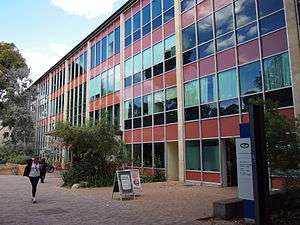Baillieu Library

The Baillieu Library is the University of Melbourne's largest discipline library, housing impressive collections relating to teaching and research in the arts, humanities and social sciences. It is located on the west side of the University’s inner city Parkville Campus, near the corner of Grattan Street and Royal Parade.[1][2] The building was designed by John Scarborough, and opened in 1959. It was refurbished in 2011–12.[2] It is named after the Baillieu family who funded the library through the William Baillieu Trust.[3]
History
- 1959 - The Baillieu Library was officially opened by Prime Minister Robert Menzies on 21 March 1959 at 2.30pm. The memorial inscription for the library foyer was unveiled by Lord Baillieu.
- 2000 - The south section of the first floor was refurbished and now houses the ‘Percy Baxter Collaborative Learning Centre’ including multimedia workstations.
- 2003 - The Information Resources Access Department was moved off The University of Melbourne University’s Parkville Campus and replaced with The University Bookshop.
- 2009 - The 50th anniversary celebrating 50 years since the opening of the Baillieu Library was held on 20 March 2009.
- 2011-2012 - The renovation of the Baillieu Library began in early 2011. Lyons Architects were appointed to the project. Works were completed in early 2012, which included the addition of a Research and Cultural Library.[4]
The building
John Francis Deighton Scarborough’s first involvement with The University of Melbourne was during the mid-1940s as a lecturer in architecture. In 1948 he designed the extension to the Old Quadrangle Library before being appointed the architect for the Baillieu Library in 1952. John Scarborough had a practice under the name of The Office of John F. D. Scarborough Architects and had two associates who were undergraduate students studying at The University of Melbourne - Ken Hunt and Ian Watkins. Ian Watkins along with Barry Axtens (whom Ian met in London) prepared the drawings for the library and Ken Atkins worked with Axel Lodewycks (who was the librarian at the time) on developing and expanding the library.[5]
Collections
The Baillieu Library consists of four levels. Each level houses a separate collection.
- Lower Ground Floor – Microforms Collection
This level is a designated as a silent study area which contains a vast amount of primary and secondary source microform materials. Photocopiers and library computers are also available for collecting data.
- Ground Floor – High Use Collection
The High Use Collection contains recommended reading materials assigned by lecturers and staff. Due to their high demand, most items have shorter loan periods, either overnight or hourly. The High Use Collection is where students and staff collect their borrowing requests. The IT Help Desk is also located on this floor.
- Second Floor – General Collection
The General Collection was created for undergraduate and postgraduate studies in Arts, Humanities and Social Sciences. This collection uses the Dewey Classification System. Folio (large size) books are located at the end of each main Dewey sequence.
- Third Floor – Special Collections
A number of different collections fall into this category: The East Asian Collection, The Louise Hanson-Dyer Music library, Special Collections, The University of Melbourne Archives and Government Documents.
The East Asian Collection focuses on materials in Chinese and Japanese languages. It contains a small English reference collection.
The Louise Hanson-Dyer Music Library supports the teaching and research programmes of the Faculty of VCA and Music at The University of Melbourne. Its resources broadly cover the history and research of Western Art Music, concentrating on Musicology, Ethnomusicology, Composition, Performance, Music Education and Music Therapy.
The Special Collection holds over 200,000 volumes of books, pamphlets and journals. There are also ‘closed access’ archival materials, classified as such due to their value, age or uniqueness in order to ensure their preservation. These materials are available for research use in the Cultural Collections Reading Room, located on the same floor.
The University of Melbourne Archives provide access to the historical records of the university, Victorian business, trade unions, community and cultural groups, as well as personal papers of many prominent individuals within these organisations. The materials are available for research use in the Cultural Collections Reading Room. Government Documents have a comprehensive collection of Australian and Victorian Government publications in addition to selected holdings for other states and territories. A substantial selection of British parliamentary debates and papers, along with publications from the United States Congress are also available.
Friends of The Baillieu
The University of Melbourne Library received its first major bequest over a century ago as George McArthur contributed his outstanding collection to the University. Since then, the Library has attracted strong support and gifts by other Library members and friends, including personal work from collector's own libraries and inheritance or financial support, allowing it to acquire many excellent publications. [6]
The general collections of the Library as well as its other work are funded through the University's grant, with an addition of approximately 40,000 volumes annually. To embrace the diversity of cultures and knowledge, the Library seeks scholarly output of publishers from all across the globe, with material acquired in 17 languages.
Despite the annual expenditure on the collections of over eleven million dollars a year, support from Friends of the Baillieu Library is indispensable to reserve Rare Book collections. The value of the work of the Friends is amply demonstrated by their help in acquiring many notable works.
References
- ↑ Campus Map (Melway 571 I6, Building 177)
- 1 2 The University of Melbourne
- ↑ Lawrence Money: "Baillieu family salutes dynasty founder", in The Age, 5 March 2012
- ↑ "History - Baillieu 50". University of Melbourne. Retrieved 25 August 2012.
- ↑ "Architects' Story - Baillieu 50". University of Melbourne. Retrieved 25 August 2012.
- ↑ The Cultural Collections
Coordinates: 37°47′55″S 144°57′34″E / 37.798503°S 144.959575°E